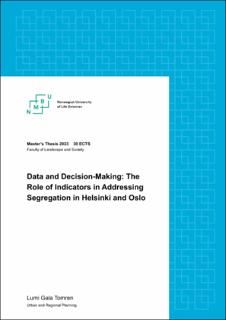| dc.description.abstract | This thesis discusses the role of indicators in segregation policies in the Nordic countries, specifically focusing on urban planning in Helsinki and Oslo. The use of indicators has gained increased popularity in policy-making, but their role in decision-making is less explored. By applying a qualitative approach, the study first finds that “problem definition” of segregation is significantly different in the two cases. Second, the study finds that the function of indicators are clearly aligned with the problem definition of segregation in each case, whether as a neighborhood problem, or a city-wide issue reproduced in several domains. Third, the study finds that policies in each city emphasize the need for indicators, but that practitioners find the utility of indicators in decision-making to be ambiguous in practice. | |
